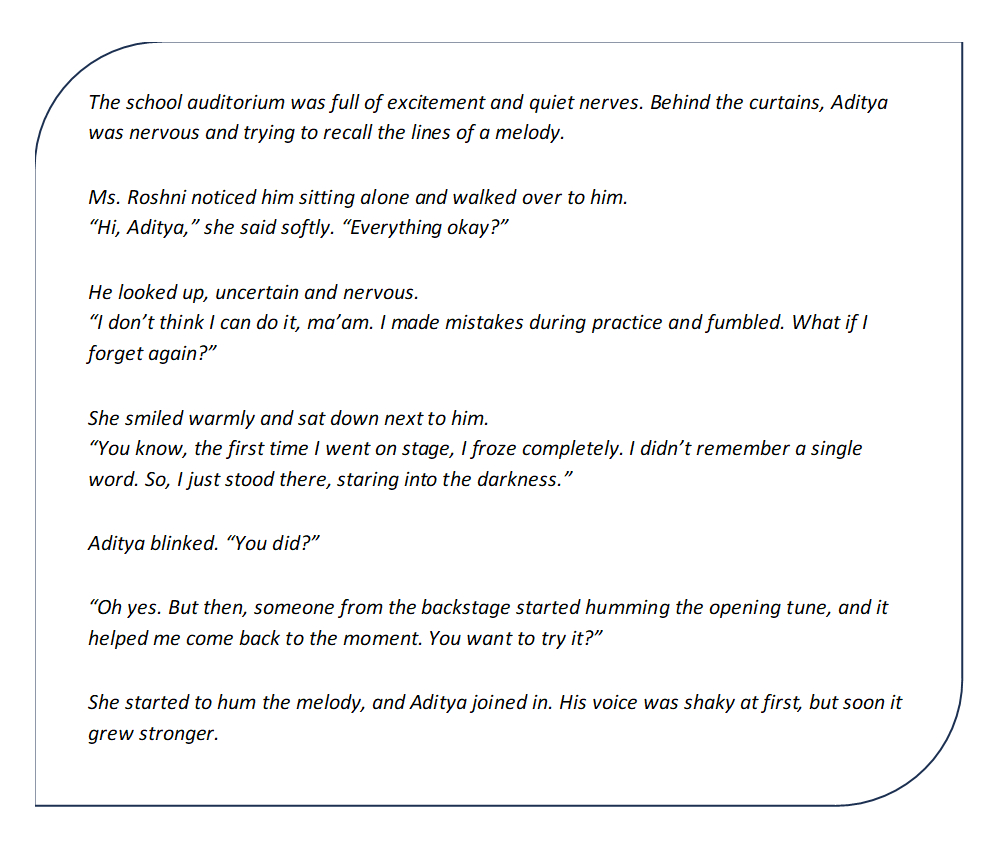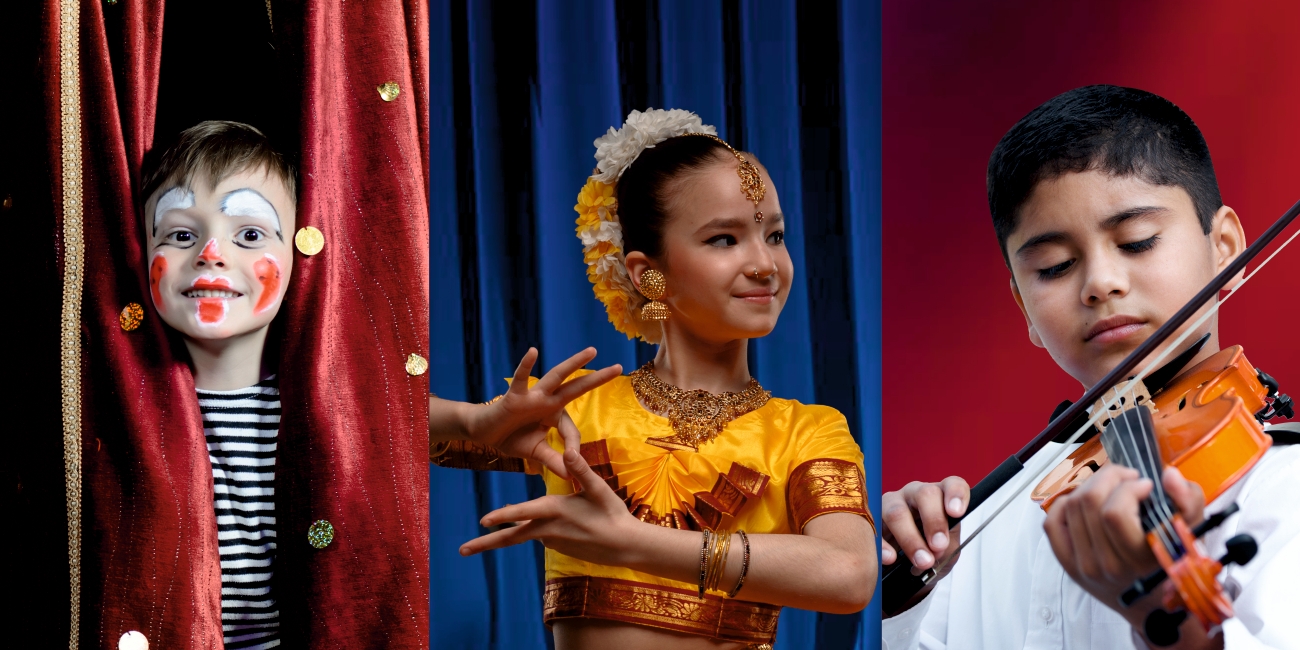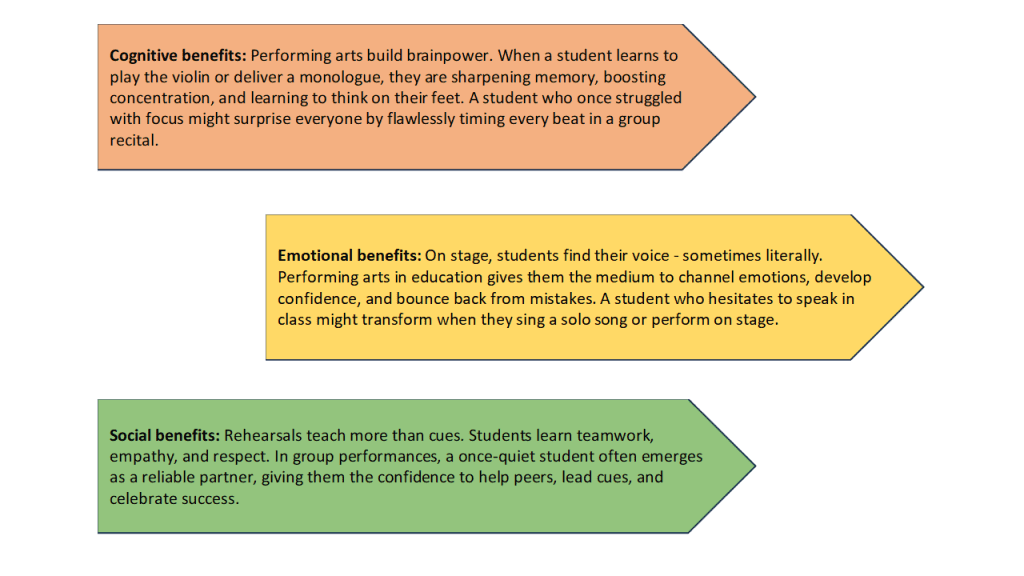![]()
Empowering confident learners and compassionate leaders through the power of the performing arts.
| In this article, you’ll discover the following: ● A new era of learning ● Art as a valuable lesson ● Rhythm and role-plays ● Classroom to character-building ● Art in every subject, empathy in every child ● Performing arts in education and its impact on the students. |
What happens when…
Storytelling becomes the syllabus?
What happens when…
Learning becomes more human-led?
A classroom isn’t defined by silence or uniform benches, but by the boundless imagination of its students. Here, learning goes beyond memorisation—it’s about expression, connection, and discovery.
In a school in Ladakh, a class begins with a roll call in rhythm. Students sing folk songs of their ancestors and retell their stories through plays. Here, they are not only learning history, but also living it.
At times when knowledge is plentiful but understanding is rare, performing arts in education combine creativity and cognition, and imagination fuels understanding.
A new era of learning
Performing arts are redefining the landscape of Indian education as it is led by inspiring figures who blend dance, music, and education,. Bharatanatyam exponent Geeta Chandran integrates classical dance in educational contexts to improve student empathy and expression. Mallika Sarabhai, a renowned Kuchipudi and Bharatanatyam dancer, brings theatre into the classrooms through the Darpana Academy of Performing Arts, whereas Nandita Das advocates for drama-in-education to introduce conversations and critical thinking among young minds.
The 2011 Why Arts Integration Improves Long-Term Retention of Content article by ResearchGate mentions that students who participate in arts tend to outperform their peers on standard measures of academic achievement.
Art as a valuable lesson
Art isn’t just an addition; the importance of arts in learning is deeper and more meaningful. Music, dance, theatre, and visual arts activate multiple areas of the brain.
The 2014 How Musical Training Affects Cognitive Development article by The National Library of Medicine states that students who undergo musical training have better verbal memory, second language pronunciation accuracy, reading ability, and executive functions. But beyond cognitive gains, the arts turn abstract ideas into hands-on experiences, making learning more human, heartfelt, and lasting.
Rhythm and role-plays
Theatre and music are often seen as extracurriculars. However, theatre and music in schools are so much more. Theatre invites students to explore identity, empathy, and social issues through various experiences. Music sharpens focus, rhythm, and emotional intelligence. Oscar-winner A.R. Rahman credits his discipline and creativity to his early training at KM Music Conservatory. Similarly, actor Naseeruddin Shah has long spoken about how theatre in schools fosters critical thinking and self-awareness.
Classroom to character-building
The true test of performing arts in education lies in the kind of people our students become. Creative learning through the arts allows students to build self-esteem and resilience, and skills that are crucial for life, not just for the stage. For instance, artist Shilo Shiv Suleman’s workshops for various schools helps students explore themes of courage, self-worth, and expression. The NGO Proud Indian empowers migrant children and children from Bengaluru’s slums by providing art-based programmes that inspire healing, boost creativity, and offer a sense of hope.
………………………

This is the true power of performing arts in education. It is not about perfection; what matters is presence, passion, and the profound joy of being seen and heard.
Art in every subject, empathy in every child
We believe that art isn’t just a subject. It is a way of seeing, feeling, and interpreting the world. Performing arts for students have numerous benefits. In fact, the National Education Policy (NEP) 2020 prioritises holistic development through arts.
The 2024 National Education Policy-2020: Research and Innovations for Transforming Higher Education article by ResearchGate explains that schools must embrace experiential learning, which includes hands-on learning, arts-integrated, sports-integrated, and storytelling-based pedagogy.
In Ladakh, the Students’ Educational and Cultural Movement of Ladakh (SECMOL) works towards reforming the government school system. Students are encouraged to learn ancient Ladakhi songs, dance, and history alongside academic knowledge.
The SHIAMAK Dance Education (SDE) Programme brings structured dance training to schools across India, giving students the chance to learn the fundamentals of movement while exploring diverse styles. Founded by A.R. Rahman in Chennai, KM Music Conservatory offers a wide range of music courses, from short-term certifications to full-fledged Undergraduate Diplomas, with specialised training in Western classical, Hindustani classical, and music technology.
Such programmes are already implemented at leading international schools, ensuring that students receive the highest level of education in both the performing arts and music.
Moreover, at VIBGYOR Group of Schools, too, we include a variety of disciplines such as music, dance, and theatre. Performing arts for students presents our students with a dynamic platform to showcase their talent. Activities such as dance, theatre and music in schools help them become well-rounded individuals through inter-house competitions, annual performances, and VIBGYOR Viva, our inter-school festival.
| VIBGYOR High’s Performing Arts Excellence Learn more |
Performing arts in education and its impact on the students
When a student steps into the spotlight for the first time, it is not just to impress, but to express. That moment of courage, connection, and creativity is the magic of performing arts in education.
Performing arts in education is an awakening. Through rhythm, role-plays, and raw emotions, students learn to listen, lead, and live with empathy. In a world that often prioritises performance over presence, performing arts bring back the heartbeat of education. They empower students to think boldly, feel deeply, and express freely. And perhaps most importantly, they remind every student that their voice matters, even when it is trembling, even when it is still finding its tune. Because performing arts in education teach the biggest lesson of all: that education is about learning to connect, and in the process, becoming a beautiful human.


